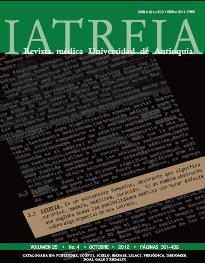Influence of the El Niño climatic event on dengue transmission dynamics in Medellín, Antioquia, Colombia
DOI:
https://doi.org/10.17533/udea.iatreia.13127Keywords:
Climate, Dengue, El Niño-Southern Oscillation, Epidemiology, TemperatureAbstract
Introduction: Dengue transmission is affected by different factors. Particularly, the socio-cultural and economic conditions play an important role in it. Additionally, it has been demonstrated that climatic variability influences the incidence of the disease by affecting the vector population dynamics and the extrinsic incubation period of the virus.
Objective: To study the role of the oceanic indicators of El Niño event in dengue transmission dynamics in the city.
Materials and methods: Three temporal scales were used for analysis of the information, namely: month, week and epidemiological period.
Results: An increase in dengue incidence was observed in the city in the years following the occurrence of the El Niño event. By means of a cross correlation analysis it was found that such incidence is significantly associated with the sea surface temperature (SST) of the El Niño 3.4 region, with a lag of 3 to 6 months.
Conclusions: The data obtained in this study become an important epidemiological tool, which may be used in dengue control programs and to help mitigate the impact of future disease epidemics in Medellin.
Downloads
Downloads
Published
How to Cite
Issue
Section
License
Papers published in the journal are available for use under the Creative Commons license, specifically Attribution-NonCommercial-ShareAlike 4.0 International.
The papers must be unpublished and sent exclusively to the Journal Iatreia; the author uploading the contribution is required to submit two fully completed formats: article submission and authorship responsibility.














